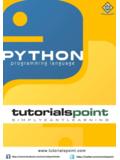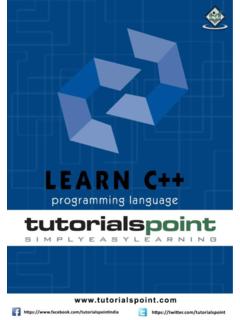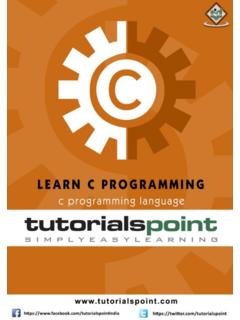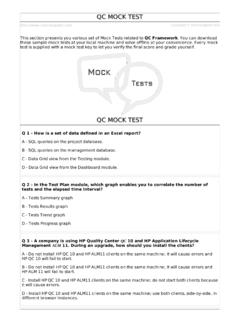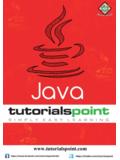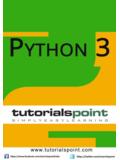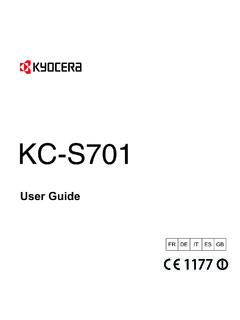Transcription of About the Tutorial
1 JSP i About the Tutorial Java Server Pages (JSP) is a server-side programming technology that enables the creation of dynamic, platform-independent method for building Web-based applications. JSP have access to the entire family of Java APIs, including the JDBC API to access enterprise databases. This Tutorial will teach you how to use Java Server Pages to develop your web applications in simple and easy steps. Audience This Tutorial has been prepared for the beginners to help them understand basic functionality of Java Server Pages (JSP) to develop your web applications. After completing this Tutorial you will find yourself at a moderate level of expertise in using JSP from where you can take yourself to next levels. Prerequisites We assume you have little knowledge of how web applications work over HTTP, what is web server and what is web browsers.
2 It will be great if you have some knowledge of web application development using any programming language. Copyright & Disclaimer Copyright 2017 by Tutorials Point (I) Pvt. Ltd. All the content and graphics published in this e-book are the property of Tutorials Point (I) Pvt. Ltd. The user of this e-book is prohibited to reuse, retain, copy, distribute or republish any contents or a part of contents of this e-book in any manner without written consent of the publisher. We strive to update the contents of our website and tutorials as timely and as precisely as possible, however, the contents may contain inaccuracies or errors. Tutorials Point (I) Pvt. Ltd. provides no guarantee regarding the accuracy, timeliness or completeness of our website or its contents including this Tutorial . If you discover any errors on our website or in this Tutorial , please notify us at JSP ii Table of Contents About the Tutorial .
3 I Audience .. i Prerequisites .. i Copyright & Disclaimer .. i Table of Contents .. ii JSP OVERVIEW .. 1 What is JavaServer Pages? .. 1 Why Use JSP? .. 1 Advantages of JSP .. 2 What is Next? .. 2 JSP ENVIRONMENT SETUP .. 3 Setting up Java Development Kit .. 3 Setting up Web Server: Tomcat .. 3 Setting up CLASSPATH .. 6 JSP ARCHITECTURE .. 7 JSP Processing .. 7 JSP LIFECYCLE .. 9 Paths Followed By JSP .. 9 JSP SYNTAX .. 12 Elements of JSP .. 12 JSP DIRECTIVES .. 23 The page Directive .. 23 JSP - The page 25 JSP iii The include Directive .. 29 JSP - Include Directive .. 30 The taglib Directive .. 32 JSP - The taglib Directive .. 32 JSP ACTIONS .. 34 Common Attributes .. 34 The <jsp:include> Action .. 35 The <jsp:useBean> Action .. 36 The <jsp:setProperty> Action .. 37 The <jsp:getProperty> Action.
4 38 The <jsp:forward> Action .. 40 The <jsp:plugin> Action .. 41 The <jsp:text> Action .. 42 JSP IMPLICIT OBJECTS .. 44 JSP CLIENT REQUEST .. 48 JSP SERVER RESPONSE .. 54 JSP HTTP STATUS CODES .. 60 Methods to Set HTTP Status Code .. 64 HTTP Status Code Example .. 64 JSP FORM PROCESSING .. 66 The Methods in Form Processing .. 66 Reading Form Data using JSP .. 66 GET Method Example Using URL .. 67 GET Method Example Using Form .. 68 POST Method Example Using Form .. 68 JSP iv Passing Checkbox Data to JSP Program .. 70 Reading All Form Parameters .. 72 JSP FILTERS .. 74 Servlet Filter Methods .. 74 JSP Filter Example .. 75 JSP Filter Mapping in .. 76 Using Multiple Filters .. 77 Filters Application Order .. 78 JSP COOKIES HANDLING .. 79 The Anatomy of a Cookie .. 79 Servlet Cookies Methods .. 80 Setting Cookies with JSP.
5 81 Reading Cookies with JSP .. 83 Delete Cookies with JSP .. 85 JSP SESSION TRACKING .. 87 Maintaining Session Between Web Client And Server .. 87 The session Object .. 88 Deleting Session Data .. 92 JSP FILE UPLOADING .. 94 Creating a File Upload Form .. 94 Writing Backend JSP Script .. 95 JSP HANDLING DATE .. 99 Getting Current Date & Time .. 100 Date Comparison .. 101 Date Formatting using SimpleDateFormat .. 101 JSP v Simple DateFormat Format Codes .. 102 JSP PAGE REDIRECTING .. 104 JSP HITS COUNTER .. 106 Hit Counter Resets .. 107 JSP AUTO REFRESH .. 108 Auto Page Refresh Example .. 108 JSP SENDING EMAIL .. 110 Send a Simple Email .. 110 Send an HTML Email .. 112 Send Attachment in Email .. 114 User Authentication Part .. 117 Using Forms to Send Email .. 117 JSP STANDARD TAG LIBRARY (JSTL) Tutorial .
6 119 Install JSTL Library .. 119 Classification of The JSTL Tags .. 119 Core 119 JSTL Core <c:out> Tag .. 121 JSTL Core <c:set> Tag .. 121 JSTL Core <c:remove> Tag .. 122 JSTL Core <c:catch> Tag .. 124 JSTL Core <c:if> Tag .. 125 JSTL Core <c:choose>, <c:when>, <c:otherwise> Tag .. 125 JSTL Core <c:choose>, <c:when>, <c:otherwise> Tag .. 127 JSTL Core <c:choose>, <c:when>, <c:otherwise> Tag .. 128 JSTL Core <c:import> Tag .. 129 JSP vi JSTL Core <c:forEach>, <c:forTokens> Tag .. 130 JSTL Core <c:forEach>, <c:forTokens> Tag .. 132 JSTL Core <c:param> Tag .. 134 JSTL Core <c:redirect> Tag .. 135 JSTL Core <c:url> Tag .. 136 Formatting Tags .. 137 JSTL Core <fmt:formatNumber> Tag .. 138 JSTL Core <fmt:parseNumber> Tag .. 141 JSTL Core <fmt:formatDate> Tag .. 143 JSTL Core <fmt:parseDate> Tag .. 146 JSTL Core <fmt:bundle> Tag.
7 148 JSTL Core <fmt:setLocale> Tag .. 151 JSTL Core <fmt:setBundle> Tag .. 153 JSTL Core <fmt:timeZone> Tag .. 154 JSTL Core <fmt:setTimeZone> Tag .. 156 JSTL Core <fmt:message> Tag .. 157 JSTL Core <fmt:requestEncoding> Tag .. 159 SQL tags .. 160 JSTL SQL <sql:setDataSource> Tag .. 161 JSTL SQL <sql:query> Tag .. 163 Create Data Records .. 164 JSTL SQL <sql:update> Tag .. 166 Create Data Records .. 167 JSTL SQL <sql:param> Tag .. 169 Create Data Records .. 171 JSTL SQL <sql:dateParam> Tag .. 173 Create Data Records .. 174 JSP vii JSTL SQL <sql:transaction> Tag .. 176 Create Data Records .. 178 XML Tags .. 180 JSTL XML <x:out> Tag .. 182 JSTL XML <x:parse> Tag .. 183 JSTL XML <x:set> Tag .. 185 JSTL XML <x:if> Tag .. 187 JSTL XML <x:forEach> Tag .. 188 JSTL XML <x:choose>, <x:when>, <x:otherwise> Tags .. 190 JSTL XML <x:choose>, <x:when>, <x:otherwise> Tags.
8 192 JSTL XML <x:choose>, <x:when>, <x:otherwise> Tags .. 194 JSTL XML <x:transform> Tag .. 196 JSTL XML <x:param> Tag .. 199 JSTL Functions .. 201 JSTL fn:contains() Function .. 203 JSTL fn:containsIgnoreCase() Function .. 204 JSTL fn:endsWith() Function .. 205 JSTL fn:escapeXml() Function .. 206 JSTL fn:indexOf() Function .. 207 JSTL fn:join() Function .. 208 JSTL fn:length() Function .. 209 JSTL fn:replace() Function .. 210 JSTL fn:split() Function .. 210 JSTL fn:startsWith() Function .. 211 JSTL fn:substring() Function .. 212 JSTL fn:substringAfter() Function .. 213 JSTL fn:substringBefore() Function .. 214 JSP viii JSTL fn:toLowerCase() Function .. 215 JSTL fn:toUpperCase() Function .. 216 JSTL fn:trim() Function .. 216 JSP DATABASE ACCESS .. 218 Create Table .. 218 Create Data Records .. 219 SELECT Operation.
9 219 INSERT Operation .. 221 DELETE Operation .. 222 UPDATE Operation .. 224 JSP XML DATA .. 226 Sending XML from a JSP .. 226 Processing XML in JSP .. 226 Formatting XML with 228 JSP JAVABEANS .. 231 JavaBeans Properties .. 231 JavaBeans Example .. 231 Accessing JavaBeans .. 232 Accessing JavaBeans Properties .. 233 JSP CUSTOM TAGS .. 235 Create "Hello" Tag .. 235 Accessing the Tag Body .. 236 Custom Tag Attributes .. 238 JSP ix JSP EXPRESSION LANGUAGE (EL) .. 242 Simple Syntax .. 242 Basic Operators in EL .. 243 Functions in JSP EL .. 244 JSP EL Implicit Objects .. 245 The pageContext Object .. 245 The Scope Objects .. 246 The param and paramValues Objects .. 246 header and headerValues Objects .. 247 JSP EXCEPTION HANDLING .. 248 Using Exception Object .. 248 Using JSTL Tags for Error Page.
10 250 Using Block .. 252 JSP DEBUGGING .. 253 Using () .. 253 Using the JDB Logger .. 254 Debugging Tools .. 256 Using JDB Debugger .. 257 Using Comments .. 257 Client and Server Headers .. 257 JSP SECURITY .. 258 Role Based Authentication .. 258 Form Based Authentication .. 260 Programmatic Security in a Servlet/JSP .. 262 JSP x JSP INTERNATIONALIZATION| I18N| L10N .. 263 Detecting Locale .. 263 Languages Setting .. 265 Locale Specific Dates .. 266 Locale Specific Currency .. 267 Locale Specific Percentage .. 268 JSP 11 What is JavaServer Pages? JavaServer Pages (JSP) is a technology for developing Webpages that supports dynamic content. This helps developers insert java code in HTML pages by making use of special JSP tags, most of which start with <% and end with %>. A JavaServer Pages component is a type of Java servlet that is designed to fulfill the role of a user interface for a Java web application.

